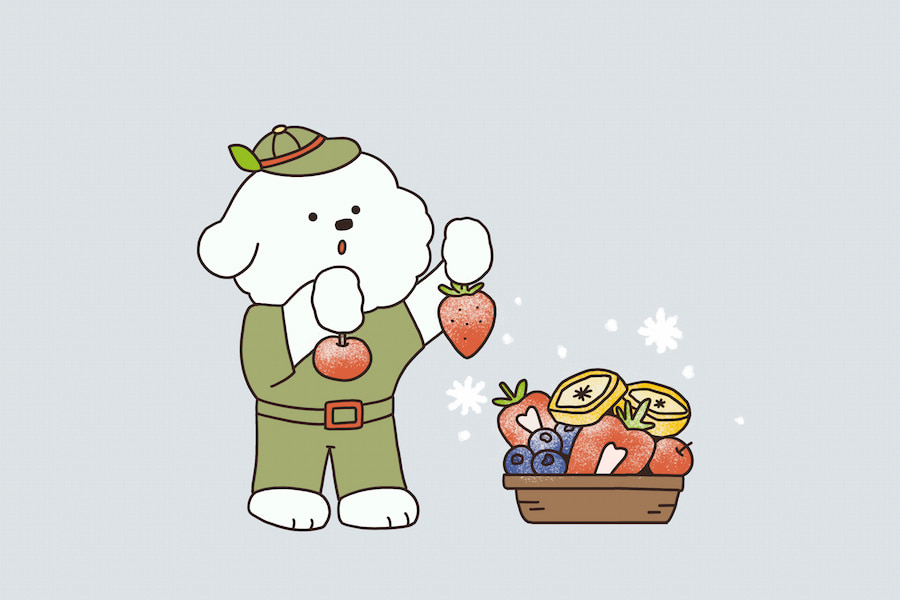Made from simplicity and nutritional worth, homemade dog treats have become popular among pet owners. From dried to freeze-dried choices, there is something for every dog whether your search is for simple homemade treats or for homemade dog treats for sensitive stomachs.
In this article, we will discuss several kinds of homemade dog treats along with vet-approved recipes including dried pollock and freeze-dried fruits and vegetables. These treats are not only great; they also abound in natural nutrients that enhance your dog’s general wellbeing.
We will also discuss useful advice on how long homemade dog treats keep so you can make sure they remain fresh for your dog to enjoy. By the conclusion of this article, you will have all the knowledge required to make nutritious homemade dog treats your dog will enjoy—and you will feel fantastic knowing exactly what is in them.

At Lee&Pol, we stay true to the name of handmade dog treats by crafting the best snacks for your pet with care and without the use of machines!
Homemade Dog Treats
Homemade dog treats have grown in popularity as more people search for better substitutes for conventional pet goodies. These treats provide not only the knowledge of exactly what is entering your dog’s diet but also the flexibility to modify components depending on particular dietary requirements. Making homemade treats lets you control components and prevent any dangerous additions whether your dog has a sensitive stomach, allergies, or is just a picky eater.
Homemade dog treats can be made at home in innumerable ways including baked, freeze-dried, and dried techniques. Nutritious foods include fruits, vegetables, and proteins providing pet owners diversity, taste, and health advantages. Furthermore, handmade treats allow you to play about with unusual combinations that satisfy your dog’s dietary needs as well as their taste.
Customization for Dietary Needs
Making homemade dog treats has mostly advantages since it allows you to customize them to your dog’s particular dietary requirements. Treats free of common allergens like gluten, soy, or synthetic preservatives will help dogs with food allergies or sensitivity especially. With alternative flour like coconut flour or chickpea flour, gluten-free homemade dog treats can be made.
Veterinarians also advise avoiding high-sugar treats for pets suffering with diseases like diabetes. Natural sweetening for treats can come from ingredients like bananas or unsweetened applesauce, which won’t change blood sugar readings. Similarly, depending on your dog’s particular health issue, vets may advise restricting proteins or fats; homemade recipes make management of these easier.
Customizing treats guarantees your dog will have an interesting and healthy food whether it’s a freeze-dried fruit snack or a dried meat strip.
Why Vets Prefer Natural Ingredients?
Made-from- scratch treats are preferred by veterinarians over commercial ones as usually they include fewer synthetic components. Made with natural, whole foods—more digestible and with greater nutritional value than processed choices—healthy homemade dog treats are created. Made-from- scratch goodies also let pet owners avoid harmful components including artificial preservatives, fillers, and hazardous byproducts sometimes included in store-bought treats.

Types of Homemade Dog Treats
Making homemade dog treats calls for knowledge of the several techniques applied in their preparation. Two of the most often used techniques are dried and freeze-dried; other alternatives are baked, raw, and even no-bake delicacies. In terms of nutrition, texture, and shelf life each kind has its own advantages.
Dried Homemade Dog Treats
Drying is the process of gradually eliminating moisture from foods under low heat. Though they have a far longer shelf life than raw or baked cookies, dried dog treats frequently retain most of the original nutrients. Eliminating water also sharpens the taste, which dogs usually find rather pleasing.
Ingredients like chicken, beef liver, and sweet potatoes allow one to create these delicacies. Dogs that appreciate a crunchy texture may also get great satisfaction from dried fruits and vegetables. Dog owners trying to provide a protein-rich treat free of preservatives will find dried beef handy.
One main advantage of dried treats is their simplicity of storage. They will keep for weeks or even months if kept cold, and dry. Pet owners can avoid allergens or additives found in store-bought versions by making their own since they are handcrafted. Furthermore, it usually helps flavors to be more naturally preserved, which increases the appeal of the homemade dog treats for picky dogs.

Freeze-Dried Homemade Dog Treats
By freezing the components first and then eliminating moisture via a vacuum process, freeze drying takes preservation to yet another level. Though more complicated than drying, this method provides further advantages in terms of taste retention and nutrient preservation. Since the procedure does not expose the components to intense heat, freeze-dried treats typically keep their natural raw nutritional profile.
Popular selections are freeze-dried chicken, beef, turkey, and even fruits like strawberries. Many dogs love these light treats with distinctive feel than other approaches. Pet owners who follow raw diets for their dogs but desire the ease of a ready-to–eat snack love these treats since the freeze-drying method preserves the integrity of raw food.
Though they don’t always call for refrigeration, freeze-dried treats can last far longer than dried treats. But the complexity of the procedure causes them to often be more costly.

Freeze-dried dog treats are a great choice for health-conscious pet owners trying to avoid preservatives yet still get optimal nutrients.

Baked Homemade Dog Treats
Although freeze-dried and dried treats are well-liked for their shelf life, baked dog treats are more classic. Typically using basic ingredients like whole wheat flour, oats, and veggies like sweet potatoes or carrots. Baked treats call for dogs that value a softer, more familiar texture to find these treats perfect.
Baked treats can be customized to suit specific dietary needs, especially for dogs with sensitivities. For example, dog owners can opt to make homemade dog treats without peanut butter or without flour for pets with allergies.

Proper storage will help baked goods last for a few days to a week even if their shelf life is less than that of dried or freeze-dried variants.
No-Bake Dog Treats
No-bake dog treats offer another very easy and quick choice for pet owners. Usually combining peanut butter, coconut oil, and rolled oats, these treats have a chewy texture dogs appreciate. Pet owners who wish to quickly create a batch of goodies will find them perfect since they do not call for baking.
Dogs with sensitive stomachs may especially benefit from no-bake treats since they avoid high cooking temperatures that can change the digestibility of some components. They can also be tailored to fit dietary requirements by creating homemade dog treats free of eggs or flour.

Although they are ideal for dog owners who want a homemade alternative that requires little effort, no-bake treats often need to be kept in the refrigerator or freezer to prevent spoiling.
Recommended Homemade Dog Treats
Having gone over the several kinds of homemade dog treats, let’s now explore some of the finest ingredients to employ. We constantly stress the need of eating premium, nutrient-dense meals with health advantages on top of taste. My best suggestions are these:
Dried Pollock
Excellent lean protein source and good supply of healthy fats including omega-3 fatty acids is dried pollock. Promoting good skin and a lustrous coat in dogs depends on these fatty acids. Given its low calorie count as well, pollock is a fantastic choice for obese dogs who must keep a healthy weight. Freeze-drying or drying pollock keeps its nutritional value and makes storage simple over extended periods of time. Dogs enjoy the taste; this is a treat free of additional preservatives.
Fruits
For dogs, if given in moderation, many fruits are safe and healthy. Excellent choices are freeze-dried fruits like apples, blueberries, pineapples. For instance, apples are high in vitamins A and C as well as fiber; blueberries are loaded with antioxidants meant to strengthen the immune system.
Vegetables
Some vegetables are bursting with nutrients and are great homemade dog treats, much like fruits. Rich in dietary fiber and vitamins B6, C, and A—which help a dog’s general health—dried sweet potatoes are a popular choice. Another beloved food with a crisp texture that dogs appreciate are freeze-dried carrots. Because of their crunchy texture, carrots help keep your dog’s teeth clean and they are filled with beta-carotene that aids eye health.

Lee&Pol combines a variety of vegetables, fruits, and dried pollock, all beneficial for your dog’s health, and continuously researches the best treat recipes to support your pet’s well-being!
Homemade Dog Treat Recipes Vet Approved
Because they can customize recipes to fit particular health requirements including allergies, sensitivities, and dietary restrictions, vet-approved homemade dog treats are growingly popular. For dogs on specialized diets, like hypoallergenic diets or for dogs prone to stomach problems, vets sometimes suggest homemade choices. Giving pet owners simple, whole ingredient-based treats lets them offer good nutrition free from unnecessary additives.
Sweet Potato and Carrot Bites
Starting with one medium cooked sweet potato in a bowl and mixing it with one chopped carrot and optional egg for binding, preheat your oven to 350°F (175°C). Add a tablespoon of coconut oil; then, until the dough is firm but flexible, progressively mix one cup of whole wheat or gluten-free flour. On a floured surface, roll the dough out; then, using a cookie cutter or hand shaping, cut it into bite-sized bits. Arrange the goodies on a parchment paper-lined baking sheet and bake until golden brown, 20 to 25 minutes. Let the goodies cool totally before presenting them.
Banana, Blueberry, and Oat Cookies
Preheat your oven to 325°F (160°C) & start by mashing one ripe banana in a large bowl until smooth. Then add half a cup of fresh or freeze-dried blueberries, one and a half cups of rolled oats, and a tablespoon of coconut oil. If desired, include an egg for binding. Mix thoroughly, then shape the dough into small balls, flatten them slightly, and arrange them on a baking sheet lined with parchment paper. Bake for 15-20 minutes or until the cookies are firm and lightly golden. Let them cool fully before giving them to your dog.
Apple, Dried Pollock, and Mango Chews
Start by preheating a dehydrator to 135°F (57°C) or setting your oven to its lowest temperature. Core and thinly slice one apple, peel and thinly slice one mango, and cut half a cup of dried pollock into small strips. Lay the apple slices, mango slices, and pollock strips evenly on the dehydrator trays or on a parchment-lined baking sheet. Dehydrate for 6-8 hours, ensuring the apple and mango reach a leathery texture and the pollock becomes crisp. Let the treats cool completely before storing them in an airtight container for later use.
How Long Do Homemade Dog Treats Last?
Made-from- scratch foods lack preservatives; hence their shelf life is less than that of commercial ones. Making sure your dog is eating healthy, fresh food depends on knowing how long various kinds of treats last.
Room Temperature Storage
- Dried dog treats stay fresh the longest at room temperature since they contain rather little moisture. Stored in an airtight container, they keep fresh for up to 2-4 weeks.
- Freeze-dried dog treats also keep up nicely and, in a cold, dry environment they can last up to 4-8 weeks. Remember, though, that any moisture will rapidly shorten their shelf life.
- Conversely, because of the materials utilized, baked goods can go bad more quickly. Stored at room temperature in a sealed container, they taste best three to five days.
Refrigeration and Freezing
Most handcrafted dog treats keep for seven days in the refrigerator. Freezing is a terrific choice if you want to extend their shelf life more or if you have created a lot of batches. Usually, homemade goodies keep three months in the freezer.

The expiration date above is a general guideline and can change a lot depending on the ingredients, how it’s made, and how it’s stored.
Conclusion
Homemade dog treats offer a great approach to guarantee your pet buddy gets the optimum nutrients free from needless additions or preservatives. This alternative let you customize treats to fit your dog’s particular requirements regardless of the treat you choose—hydrated, freeze-dried, baked, or otherwise. Customizing ingredients for allergies, sensitivities, or preferences guarantees that your dog will appreciate treats that are both tasty and healthy. Moreover, homemade goods can last for weeks with proper preservation techniques, offering a handy and reasonably priced substitute for store-bought variety.
FAQ
Yes, there are several alternatives to peanut butter, such as pumpkin puree, unsweetened applesauce, or coconut oil.
Homemade dog treats typically last 5-7 days in the fridge, but they should be stored in airtight containers to ensure freshness.
Whole wheat flour is a common choice, but gluten-free flour like coconut flour, oat flour, or chickpea flour are excellent alternatives for dogs with sensitivities.



